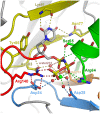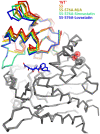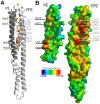An introduction to biomolecular graphics
- PMID: 20865174
- PMCID: PMC2928806
- DOI: 10.1371/journal.pcbi.1000918
An introduction to biomolecular graphics
Conflict of interest statement
One author (JV) is employed by Schrödinger LLC, distributor of the PyMOL software package.
Figures





References
-
- DeLano WL. The PyMOL Molecular Graphics System. 2008. http://pymol.org.
-
- Bottomley S, Helmerhorst E. Molecular Visualization. In: Gu J, Bourne PE, editors. Structural Bioinformatics. 2nd ed. Hoboken, NJ: John Wiley & Sons; 2009.
-
- Atwood JL, Barbour LJ. Molecular Graphics: From Science to Art. Crystal Growth & Design. 2003;3:3–8.
-
- Olson AJ. Molecular graphics and animation. In: Rossmann MG, Arnold E, Fuess H, Hahn T, Wondratschek H, et al., editors. International Tables for Crystallography. Chester, England: International Union of Crystallography; 2006.
Publication types
MeSH terms
Substances
Grants and funding
LinkOut - more resources
Full Text Sources

